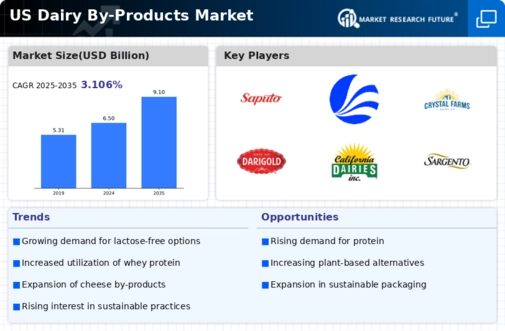Growing Export Opportunities
The dairy by-products market is witnessing an increase in export opportunities, driven by rising global demand for dairy ingredients. Countries around the world are seeking high-quality dairy by-products for use in various applications, including food, pharmaceuticals, and animal feed. The dairy by-products market is poised to capitalize on this trend, as US producers look to expand their reach in international markets. In 2025, it is projected that exports of dairy by-products could account for approximately 20% of total production, reflecting a growing interest in US dairy products abroad. This expansion into global markets may provide a significant boost to the dairy by-products market, fostering growth and innovation.
Increasing Health Consciousness
The dairy by-products market is experiencing a notable shift due to the increasing health consciousness among consumers. As individuals become more aware of the nutritional benefits associated with dairy by-products, such as whey protein and lactose, demand is likely to rise. This trend is reflected in the growing popularity of protein-rich snacks and supplements, which often incorporate dairy by-products. In 2025, the market for whey protein alone is projected to reach approximately $10 billion in the US, indicating a robust interest in health-oriented products. The dairy by-products market is thus positioned to benefit from this heightened focus on health and wellness, as consumers seek out products that align with their dietary preferences and nutritional needs.
Technological Innovations in Production
Technological innovations are playing a crucial role in enhancing the efficiency and quality of dairy by-products production. Advances in processing techniques, such as membrane filtration and enzymatic treatments, are enabling manufacturers to extract higher yields and improve the functional properties of dairy by-products. The dairy by-products market is likely to benefit from these innovations, as they not only reduce production costs but also enhance product quality. In 2025, it is anticipated that investments in technology could lead to a 10% increase in production efficiency across the sector. This focus on technological advancement may position the dairy by-products market for sustained growth and competitiveness in an evolving landscape.
Expansion of Food and Beverage Applications
The versatility of dairy by-products is driving their expansion into various food and beverage applications. Ingredients such as buttermilk powder and cheese by-products are increasingly utilized in baked goods, sauces, and dressings, enhancing flavor and texture. The dairy by-products market is witnessing a surge in demand from food manufacturers looking to innovate and diversify their product offerings. In 2025, it is estimated that the incorporation of dairy by-products in the food sector could contribute to a market growth of around 15%. This trend suggests that as food companies continue to explore new formulations, the dairy by-products market will likely see sustained growth and increased utilization across multiple segments.
Rising Popularity of Plant-Based Alternatives
While the dairy by-products market is traditionally associated with animal-derived products, the rising popularity of plant-based alternatives is influencing market dynamics. Consumers are increasingly seeking dairy alternatives, which has prompted dairy producers to innovate and create hybrid products that incorporate both dairy and plant-based ingredients. This trend may lead to a diversification of offerings within the dairy by-products market, as companies explore ways to appeal to a broader audience. The potential for growth in this segment is significant, with projections indicating that the plant-based dairy market could reach $30 billion by 2026. This shift may encourage traditional dairy producers to adapt and expand their product lines to remain competitive.





















Leave a Comment